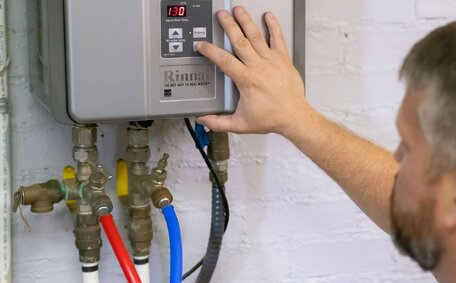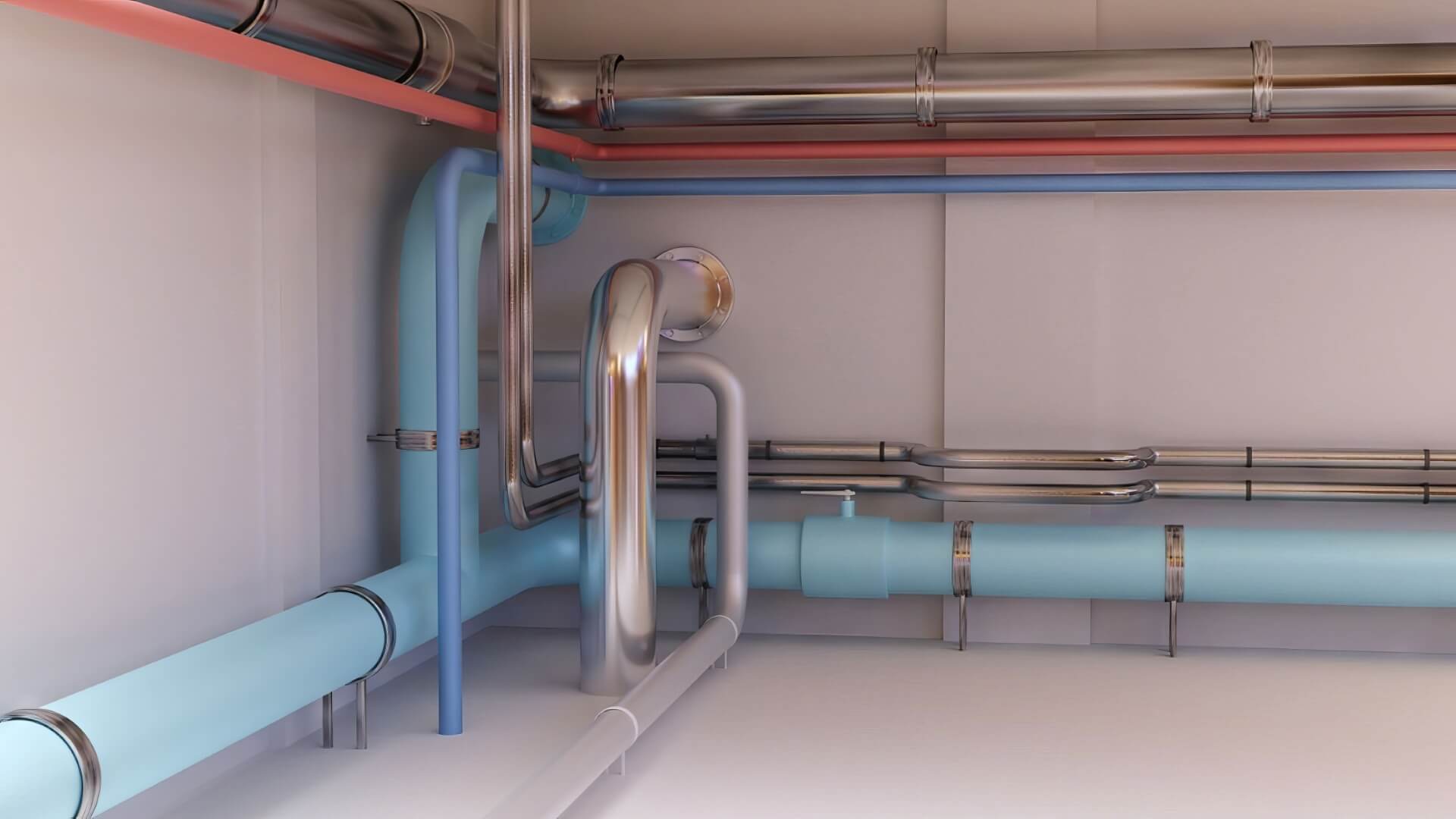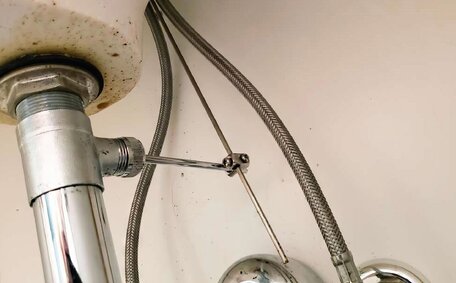What Causes Pipe Blockages and Clogs?
Understanding the typical causes of pipe blockages and clogs is key to preventing them:
- Tree root intrusion - Roots from trees and shrubs can grow into pipes, especially older clay or cast iron pipes. This is a major issue in areas like Glenwood, Sydney where tree roots are prevalent.
- Buildup of debris - Things like hair, grease, food scraps, and other debris can accumulate over time and cause a clog.
- Hard water deposits - Minerals from hard water can accumulate, narrowing pipes and restricting water flow.
- Collapsed sewer pipes - Blockages, misalignments, or settling can lead to pipe collapses, creating obstructions.
- Accumulation of fats, oils and grease - Grease and cooking fat that goes into drain pipes can cling to the interior, leading to a stubborn build up.
- Flushing unsuitable materials down toilet - Flushing items like baby wipes, sanitary products, and dental floss can get caught where tree roots can grow into and damage your pipes.
An accurate diagnosis, often requiring a CCTV drain camera inspection, enables homeowners to understand and prevent blockages. Being informed is vital to maintaining a clear plumbing system.
This is a major issue in areas like Glenwood, Sydney where tree roots are prevalent.Buildup of debris - Things like hair, grease, food scraps, and other debris can accumulate over time and cause a clog.- Slow draining sinks, tubs, or showers - If water drains slowly or not at all, this points to a clog.
- Gurgling sounds from drains - Loud gurgling from toilet, sink, tub, or shower drains as water drains is a sign of a blockage.
- Backed up drains - Sinks filling with water or toilets overflowing signal a blocked drain line.
- Main drain sewer odours indoors - Bad smells from drains inside your home often mean there is a blockage in the main sewer line.
- Pooling water - Water collecting around your drains, toilets, tubs, or sinks may indicate a clog.
- Reduced flow water pressure - A marked drop in water pressure at fixtures like taps, sinks, showers may also be one of the signs blocked drain can present.
If you’re experiencing these signs, swift action is essential to diagnose and clear clogs, avoiding costly plumbing repairs.
Slow draining sinks, tubs, or showers - If water drains slowly or not at all, this points to a clog.Gurgling sounds from drains - Loud gurgling from toilet, sink, tub, or shower drains as water drains is a sign of a blockage.Backed up drains - Sinks filling with water or toilets overflowing signal a blocked drain line.How Does Pipe Relining Work?
Pipe relining is a trenchless method of repairing damaged or blocked pipes without having to dig up and replace them. It involves inserting a flexible epoxy resin lining into the existing pipe to essentially create a new pipe within the old one.
Initially, a camera inspection locates any damage, followed by high-pressure cleaning. The resin then cures, forming a smooth, new pipe lining.
Subsequently, a resin-saturated liner is inserted and expanded to adhere to the pipe walls.
Pipe repair through relining is less invasive than traditional pipe replacement as it requires no excavation or destruction to walls, floors, or landscaping when dealing with damaged pipes. The procedure was very carefully executed, often wrapping up within a day or two, with the area being cleaned up promptly and operational pipes during the repair work.
Furthermore, drain relining addresses obstructions from tree roots and grease, extending the utility of this method beyond mere pipe restoration.
Owing to its efficiency and cost-effectiveness, our pipe relining service is a preferred option for resolving blocked drains throughout Sydney. It is suitable for both emergency repairs and regular maintenance.
Pipe relining is a trenchless method of repairing damaged or blocked pipes without havidamage or blockages. Next, a felt liner soaked in specialised epoxy resin is inserted into the pipe and inflated so it presses firmly against the interior walls. The epoxy resin is left to cure, hardening into a smooth, seamless pipe lining.
The Pipe Relining Process Step-by-Step
Here is a step-by-step outline focusing on the drain pipe relining procedure:
- Initial inspection - A plumber will utilise a CCTV drain camera to conduct a meticulous inspection of the drainage system’s pipes, seeking any damage, cracks, or areas where high pressure cleaning might be required to clear root-caused blockages.
- Pipe cleaning - The pipes cleaning can be carried out using high-pressure water jetting, mechanically scrubbing or a combination to remove built-up gunk, a task done with utmost precision.
- Resin liner installation - A flexible epoxy resin-soaked liner is inserted into the pipe and inflated to press against the inner walls.
- Curing - The resin liner is left to cure and harden, usually taking a few hours. Hot water or steam may be used to accelerate curing.
- Second inspection - The drain camera embarks on another journey down the pipeline to check for any defects and to confirm it did a great job up to standard.
- Reconnection - The pipes are reconnected to restore water flow and full functionality is confirmed.
Sewer pipe relining rehabilitates your pipes internally without the need for excavation, offering a swift, efficient and least disruptive option for plumbing needs.
The Benefits of Pipe Relining vs Traditional Pipe Replacement
Our pipe relining strategies present multiple benefits over conventional methods, particularly effective in Sydney drain blocked situations:
- Minimal excavation - Pipe relining circumvents the process of digging up your yard, driveway, or flooring to reach the problematic pipes. This prevents damage to landscaping, structures and interior finishes throughout drains Sydney regions.
- Less disruption - Due to the non-intrusive methodology of pipe relining, Both homes and businesses experience negligible interruptions, enabling daily activities to come out unimpeded amidst ongoing drain repairs. Pipe replacement often requires shutting off water and tearing up finished surfaces, an inconvenience that can be avoided with our trenchless solutions that ensure your daily activities can proceed as the repair teams came out for work.
- Faster repairs - Pipe relining is typically completed in 1-2 days, as opposed to the 3-5 days for pipe replacement, ensuring a quicker restoration of services.
- Improved flow - The joint-free interior of the new epoxy liner enhances water flow and pressure, an advantage over traditional vinyl, PVC, or cast iron pipe replacements.
- Long-lasting - With a lifespan exceeding 50 years, pipe relining effectively creates a brand-new conduit within the existing pipeline.
- Cost-effective - Pipe relining costs are generally 30-50% lower than complete pipe replacements.
In Glenwood and beyond, pipe relining safeguards your landscape from excavation, providing a proficient and minimally disruptive plumbing restoration.
When is Pipe Relining the Best Solution for a Blocked Pipe?
Relining can rejuvenate flow in pipes clogged by roots, grease, or debris, avoiding disruptions tied to traditional pipe replacement. However, severely corroded or collapsed drains might necessitate complete pipe replacement.
Questions to Ask a Professional About Pipe Relining
When considering pipe relining, it’s important to discuss the details with a professional plumber. Here are some key questions to ask:
- How do you determine if my pipes are suitable for relining?
- What is the process like and how long will it take?
- How do you prep the pipes before applying the epoxy resin liner?
- What benefits does relining provide over traditional pipe replacement?
- How long can I expect the relining to last?
- How will the relining work well to improve water flow and pressure in my pipes?
- How much disruption will the relining work cause to my home or business?
- What are the total costs involved with relining my pipes?
- Do you provide any warranties or guarantees on your pipe relining work?
- Can you relining pipes running under concrete slabs or other hard to access areas?
Asking these questions clarifies whether relining suits your needs and what to anticipate from the service. A dependable plumbing company should be transparent in their responses. We at Glenwood Plumbing, extend comprehensive relining services and openly discuss the pros, cons, and costs involved.
When considering pipe relining, it’s important to discuss the details with a professional plumber.
How do you determine if my pipes are suitable for relining?What is the process like and how long will it take?How do you prep the pipes before applying the epoxy resin linwood plumbing drainage systems:- Avoid pouring fats, oils and grease down the drain to prevent clogs from developing. These substances can gradually accumulate, which can lead to persistent clogs.
- Employ drain strainers in sinks showers to capture hair and culinary remnants before they make their way down drain pipes in your home.
- Flush only toilet paper and human waste down toilets to clear blocked pathways. Baby wipes, sanitary products, and other non-degradable items should not be flushed down as they can get stuck.
- Run hot water for a few minutes each week to melt grease deposits and keep drains clear.
- Employ enzyme cleaners or a baking soda and vinegar blend, which can cause a reaction to clear your blocked drain and ensure continued smooth water flow.
- Engage a professional plumber to conduct regular inspections with a hydro jet to remove debris, thereby preventing massive blockages and help clear your pipes.
- Replace old pipes prone to cracks, roots and clogs. New pipe lining with epoxy resists buildup and enhances longevity.
- Maintain your storm water pipes free of leaves and detritus to avert water pooling and passage obstructions.
Taking preventive measures by modifying household habits and getting regular professional drain cleaning can go a long way towards avoiding expensive plumbing emergencies from blocked pipes.
DIY Ways to Clear Minor Clogs
For minor clogs in sinks, showers, and tubs, you can try DIY remedies or enlist a plumber if needed:
- Use a plunger for a clogged drain. Securely position it over the drain and pump vigorously to remove the clog.
- Utilise drain snakes - Insert a hand crank auger or a slender plastic drain snake into your pipeline to fracture and capture debris.
- Pour boiling water down the kitchen sink slowly to dissolve soap scum and grease.
- Mix 1/2 cup baking soda with 1/2 cup vinegar, pour it down the drain, cover and leave for 15 minutes.
- Hand removal - In bathroom sink drains, unscrew the drain cap and get your hands involved to extract hair or detritus.
It’s best to avoid chemical drain cleaners due to potential pipe damage; consult your plumber for safer options. Should DIY methods fall short, contact a professional plumber to resolve the clog.
When to Call a Professional Plumber
Certain plumbing issues go beyond DIY remedies and call for professional expertise:
- Professionals should address blocked sewer lines, indicated by significant obstructions or completely backed-up toilets, as they have the necessary equipment to clear them.
- Sewage backups - Any backups, overflows or leaks from your sewer drain indicate a serious issue needing urgent professional attention to identify and resolve.
- No hot water - If you have no hot water at all, your hot water system likely needs repair or replacement which is best handled by a professional.
- Leaking pipes - Detecting the origin of leaks inside walls or under floors and repairing burst, broken or cracked drain pipes calls for plumbing expertise.
- Low water pressure - Persistent poor water flow at multiple fixtures generally indicates an underlying issue needing diagnosis and correction by a plumber.
- Faulty fixtures/appliances - Malfunctioning toilets, taps, water heaters and other appliances should be serviced by qualified plumbers to avoid DIY mishaps.
- Gas leaks - The smell of gas demands immediate attention. Shut off the main valve and call emergency plumbers to inspect and rectify dangerous leaks.
- Drain line damage - Severe pipe damage caused by tree roots, shifting soil or age can only be properly repaired or replaced by professionals.
For substantial plumbing issues, our skilled team provides reliable solutions for your drains. Bypass DIY risks; contact Glenwood Plumbing for prompt repairs or preventive maintenance.






